![]()
Astbury Ware
![]()
![]() His ware was better formed, being finished on a lathe;
better surfaced, with a coating of white pipe clay; and harder and lighter
because of the introduction of calcined flint into the body. Astbury's red or
buff earthenware was ornamented by white relief ships, figures, and
fortifications.
His ware was better formed, being finished on a lathe;
better surfaced, with a coating of white pipe clay; and harder and lighter
because of the introduction of calcined flint into the body. Astbury's red or
buff earthenware was ornamented by white relief ships, figures, and
fortifications.

![]() Astbury products include agateware and tortoiseshell
ware; black earthenware with relief ornament in
white; glazed earthenware in various brown, fawn, and buff shades
stamp-decorated with white pipe clay; salt-glazed stoneware; white and cream
earthenware; terra-cotta, which was a hard red unglazed earthenware with
geometric incised lathe-cut decoration; sgraffito
(scratch-decorated) earthenware; and figures.
Astbury products include agateware and tortoiseshell
ware; black earthenware with relief ornament in
white; glazed earthenware in various brown, fawn, and buff shades
stamp-decorated with white pipe clay; salt-glazed stoneware; white and cream
earthenware; terra-cotta, which was a hard red unglazed earthenware with
geometric incised lathe-cut decoration; sgraffito
(scratch-decorated) earthenware; and figures.
![]() The distinctive Astbury figures consisted of men, animals,
and birds, singly or grouped, modelled in clay, slip-coated, and decorated in a
coloured slip (which was later superseded by metallic oxide colours). Figures
consist of couples beneath a tree, musical groups of individual performers,
equestrian figures, and Chinese figures.
The distinctive Astbury figures consisted of men, animals,
and birds, singly or grouped, modelled in clay, slip-coated, and decorated in a
coloured slip (which was later superseded by metallic oxide colours). Figures
consist of couples beneath a tree, musical groups of individual performers,
equestrian figures, and Chinese figures.

![]()
questions / comments? email Steve Birks steveb@netcentral.co.uk